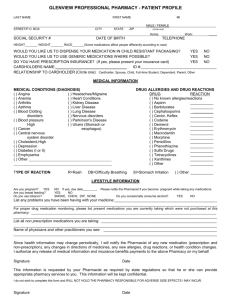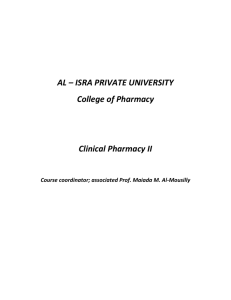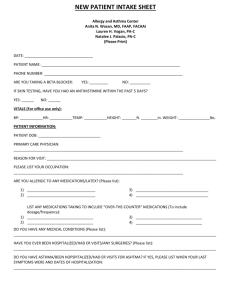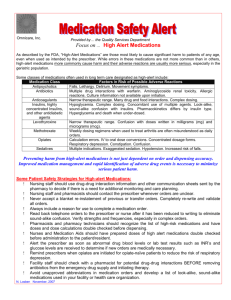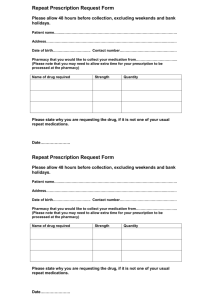ADVENTIST MDWEST HEALTH REGIONAL POLICY PROFILE High Alert Drugs
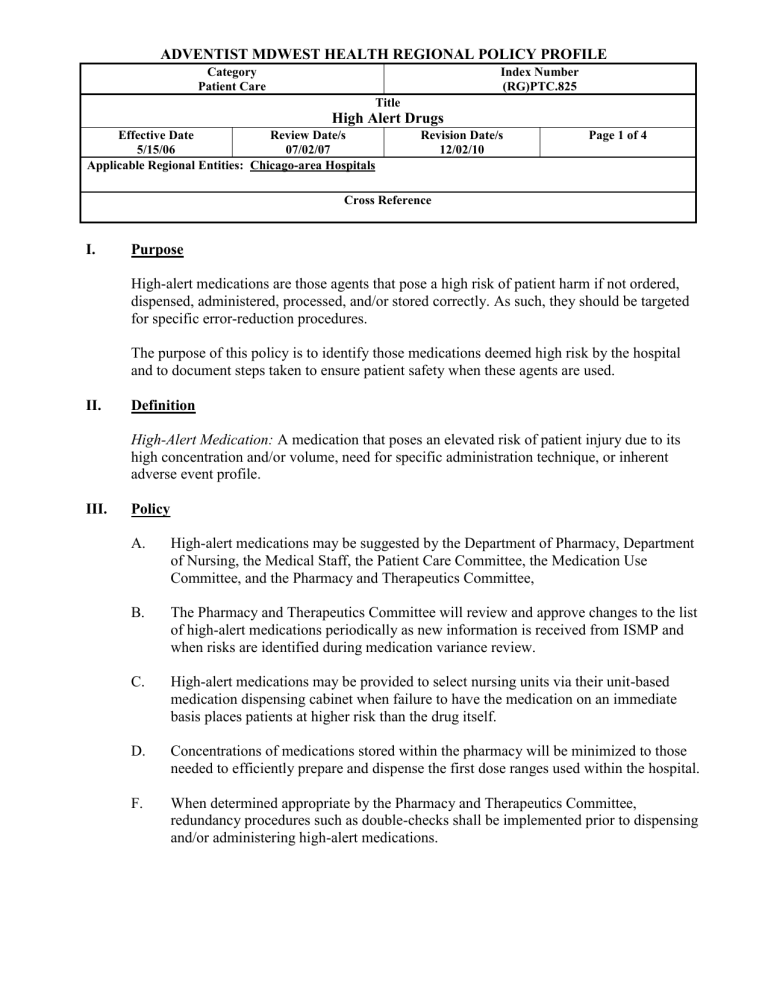
ADVENTIST MDWEST HEALTH REGIONAL POLICY PROFILE
Category
Patient Care
Title
High Alert Drugs
Effective Date
5/15/06
Review Date/s
07/02/07
Applicable Regional Entities: Chicago-area Hospitals
Revision Date/s
12/02/10
Index Number
(RG)PTC.825
Page 1 of 4
Cross Reference
I.
Purpose
High-alert medications are those agents that pose a high risk of patient harm if not ordered, dispensed, administered, processed, and/or stored correctly. As such, they should be targeted for specific error-reduction procedures.
The purpose of this policy is to identify those medications deemed high risk by the hospital and to document steps taken to ensure patient safety when these agents are used.
II.
Definition
High-Alert Medication: A medication that poses an elevated risk of patient injury due to its high concentration and/or volume, need for specific administration technique, or inherent adverse event profile.
III.
Policy
A. High-alert medications may be suggested by the Department of Pharmacy, Department of Nursing, the Medical Staff, the Patient Care Committee, the Medication Use
Committee, and the Pharmacy and Therapeutics Committee,
B. The Pharmacy and Therapeutics Committee will review and approve changes to the list of high-alert medications periodically as new information is received from ISMP and when risks are identified during medication variance review.
C. High-alert medications may be provided to select nursing units via their unit-based medication dispensing cabinet when failure to have the medication on an immediate basis places patients at higher risk than the drug itself.
D. Concentrations of medications stored within the pharmacy will be minimized to those needed to efficiently prepare and dispense the first dose ranges used within the hospital.
F. When determined appropriate by the Pharmacy and Therapeutics Committee, redundancy procedures such as double-checks shall be implemented prior to dispensing and/or administering high-alert medications.
ADVENTIST MDWEST HEALTH REGIONAL POLICY PROFILE
Category
Patient Care
Title
High Alert Drugs
Effective Date
5/15/06
Review Date/s
07/02/07
Applicable Regional Entities: Chicago-area Hospitals
Revision Date/s
12/02/10
Index Number
(RG)PTC.825
Page 2 of 4
Cross Reference
IV.
Procedure:
Additions or changes to the list of high-alert medications may be reviewed by the Department of Pharmacy. The suggestions will be forwarded to the Pharmacy and Therapeutics Committee for approval.
DISTRIBUTION:
Email distribution to Adventist Midwest Health Leadership
Posting on the Adventist Midwest Health Intranet
APPROVAL:
Regional Executive Council (Date): 5/15/06; 07/02/07; 12/02/10
Other Required Committee/s:
AHH/ALMH Pharmacy and Therapeutics Committee
AHH/ALMH Medical Executive Committee
AGH Pharmacy and Therapeutics Committee
(Date): 09/07/05; 05/02/07, 02/04/09; 02/04/09
(Date): 09/09/05; 06/08/07, 02/13/09
(Date): 08/18/05; 05/15/07, 02/17/09; 08/17/10
AGH Medical Executive Committee (Date): 09/06/05; 06/14/07; 08/19/10
ABH Pharmacy and Therapeutics Committee (Date): 08/11/10
ABH Medical Executive Committee (Date): 08/19/10
High-Alert Medications and Risk-Reduction Strategies
Drug or Drug
Class
Chemotherapy drugs (all)
Insulin
High-Alert Features Risk-Reduction Strategy
Drugs are toxic by design
Look/sound alike
Look/sound alike issues
Excessive dose may be lethal
Potassium chloride, phosphate and acetate injections
High concentration or quantity may cause arrhythmia or tissue damage if infiltrated
Sodium chloride, phosphate and acetate injection
• Concentrated sodium chloride more than
0.9% (MT 0.9%), sodium phosphate and sodium acetate may cause hypernatremia
Keep all chemotherapy drugs from floor stock
See regional LASA Drugs policy (PTC 633)
Second nurse verification
Eliminate all insulin from nursing floor stock
Standardize IV infusion administration concentration to 1unit/ml
See Regional Drug Infusion
Concentrations (PTC 631)
Second nurse verification for
IV insulin administration
Provide pre-mixed KCI in limited concentrations (10-
40meq in 50-100 ml)
Eliminate concentrated KCl vials from all patient care areas
See regional Concentrated IV
Electrolyte Solutions policy
(PTC 613)
Concentrated sodium chloride (MT 0.9%), sodium phosphate and sodium acetate is available only in pharmacy
See regional Concentrated
IV Electrolyte Solutions policy (PTC 613)
Approved Nursing Units
None
None
Premixed bags are available for
Open Heart procedures at La
Grange and Hinsdale
Premixed bags are available in
Pyxis at GlenOaks ICU and ER, to be used when pharmacy is closed
None
High-Alert Medications and Risk-Reduction Strategies
Drug or Drug
Class
Heparin (excluding flush concentrations)
High-Alert Features Risk-Reduction Strategy
Multiple therapeutic concentrations lead to dosing errors
Standardize IV heparin concentration to
25,000 units/250 ml IV
See Regional Drug Infusion
Concentrations (PTC 631)
Second nurse verification for
IV administration of anticoagulation drugs
Approved Nursing Units
Heparin 25,000 units/250ml
IV bags available in Pyxis.
Vinca alkaloid, including:
□ Incisive
□ Vinblastine
□ Vinorelbine
Fatal if inadvertently administered intrathecally
Prohibit dispensing for IV push administration.
Dispense only in smallvolume IV minibags
Second nurse verification
PCA and Epidural infusion of narcotics, including but not limited to:
□ Morphine
□ Fentanyl
□ Hydromorp hone
May cause harm or fatality if the wrong dose is inadvertently infused.
Second nurse verification

